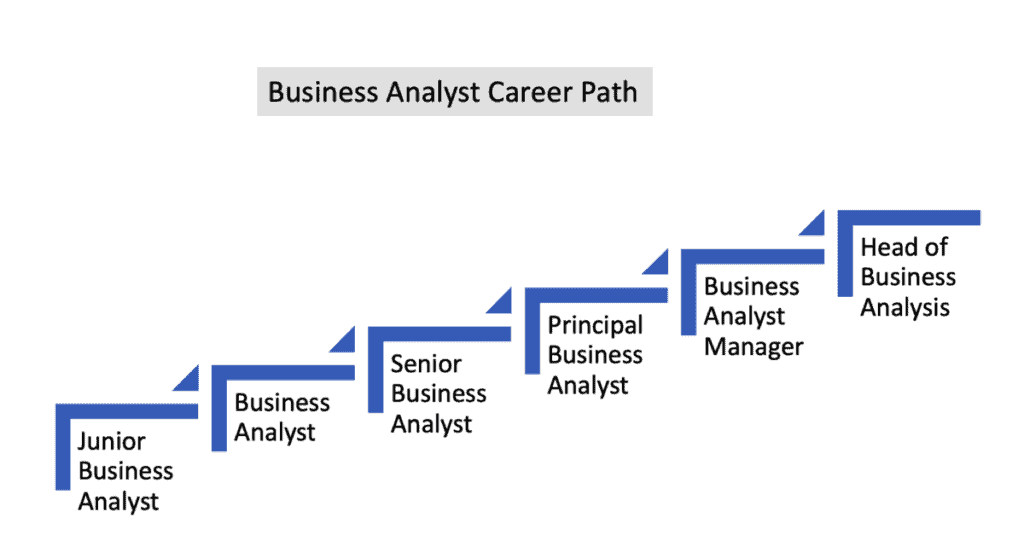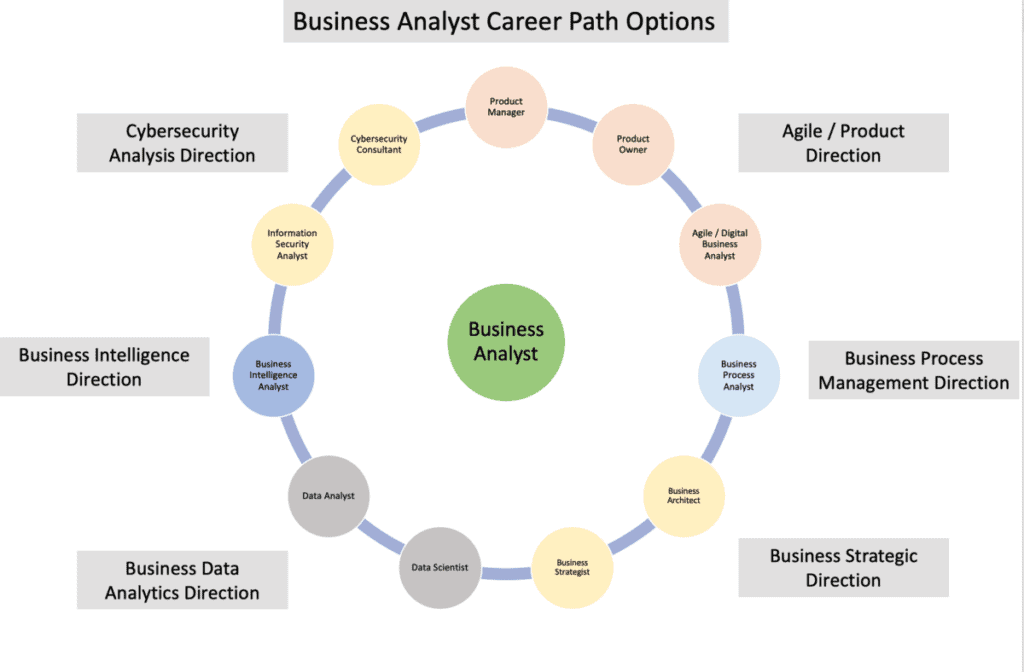Having control of your business analyst career path is even more important than it was several years ago to provide a basis for business analyst career growth that is meaningful and fulfilling and which gives you business analyst career opportunities.
The new ways of working (WoW) such as agile and digital transformation has raised questions about the value of the business analyst role and has led the business analysis profession to continually extend itself to stay relevant and provide value.
The agile certifications
Most business analyst enjoy their jobs and the range of possibilities that it offers. Of course, there may be times when guidance is needed to help progress your business analyst career and knowing how to progress whether in the business analysis profession or to seek an alternative path that builds upon your business analysis skillset may be an option.
So, the question is – how do you stay relevant as a business analyst and take control of your business analyst career path? One perspective to consider is to understand the patterns that help achieve a successful career and use a career strategy framework. The Hidden Patterns of Success by Christopher Lomas
This article (with permission from Christopher Lomas) provides a brief overview of the framework and provides a useful reference for the business analyst when seeking and looking for direction to control and progress their business analysis careers. The article will also help those who are seeking guidance on a career development plan for business analyst or building a business analyst career path.
The career progression of business analysts is important the continual growth of the business analyst profession.
Table of Contents

Business Analyst Career Path – The Four Career Phases
There are four career phases that we all typically go through:
- Expectations
- Trust
- Ownership
- Identity
Expectations
Firstly, when we start our careers, we need to understand what is expected of us, and we need to have fair expectations. Typically, you may be either aspiring to be a business analyst or new into the role and performing as a junior business analyst. Are you clear on your role as a business analysis? Are you clear on the various tools and techniques? Are you clear on what is expected of you from your organisation?
A junior business analyst can have a varied start to their career. Some may have the opportunity to be on a development program and be on the road to business analysis certification.
What is important at this stage is to gain project experience and start to apply business analysis techniques
This is also a good stage to understand what parts of the role you enjoy. Being involved on projects also allows the junior business analyst to see and understand other roles that could be of interest (perhaps in the future).
Trust
As we progress from junior business analyst to business analyst, we have to be trusted to deliver and demonstrate trust. Are you able to do things right and just get on with the work without being micro-managed and deliver on the work that has been set for you? If not see our business analysis recommended webinar and courses
Ownership
In the third career phase, we need to take ownership for the work that we do. Typically, you may transition from business analyst to senior or lead business analyst in this phase you will be given ownership for key initiatives. It is also useful to share knowledge when you are given ownership – avoid being the bottleneck and start sharing and teaching others.
Identity
Lastly, we need to build and leverage identity for the part of the business or work that we do. Typically, you may be transitioning from a senior or lead business analyst to a principal business analyst, business analyst manager or head of a business analyst practice.
Some business analyst may also transition into becoming an independent/contracting business analysis or a business analyst consultant where-by having an identity will help differentiate you in getting you key roles or staying employed in more difficult employment times. You may become known for something, developing original thought. It is not really about having status, but you can have a level of influence.
Some business analyst may see this stage as an opportunity to transition into another role such as
- Business Architect
and transition from a Business Analyst to a Business Architect
- Project Manager
- Product Owner / Product Management
- Product Analyst
- Solution Architect
A lot will depend on what aspect of the role that you enjoy and whether you wish to move away from business analysis or even if your company has removed the business analyst role and instead moved those roles into a business architect, product owner/product management position.

Business Analyst Career Path – Five Key Accelerators
There are five key accelerators that will help make the transition across the four phases smoother:
- Mentor
- Skills
- Create
- Connect
- Teaching Others
Mentor
You should find a mentor. A mentor can be anyone who helps you develop trust or identity. A mentor can help you focus, help you decide what you do next; and help you see blind spots that perhaps that you cannot see. Remember you can have more than one mentor – also on different aspects on what you need to learn on. Business Analyst Mentor provides guidance (through blog articles) on this site and one to one business analysis mentoring services.
Everyone should consider having a mentor
Skills
It is important to invest in your skills. You may be in a new role or company – you need to develop new skills to help demonstrate trust. It may take time to develop the new skills – but it is an area that needs to be considered.
Business Analyst Mentor guides by working with partners and determining the best training from the business analysis community that will help up-skill our community of followers. You can review recommended business analysis webinars and courses
It is not unusual from around 3 years that a junior business analyst may start to consider their career path a bit further. There will be options of promotion to a business analyst (if this has not already happened) – remember organisations have different programs and time in role before offering promotions.
Most junior business analyst will continue their development and progress their careers to business analyst, senior business analyst and will work on their business analysis certifications for example if studying for the IIBA will be progressing through the ECBA and CCBA. Once on the certification journey, the ultimate goal will be to obtain the CBAP.
Once a business analyst has been working for more than 8 years a more, they have good project experience to take on more senior and enterprise roles and may consider consulting to develop further or become involved in programmes of work that is more complex.
Perhaps after 10 years, they may consider being independent.
A business analyst can also extend their business analysis skill set by taking courses or learning about specialist subjects such as:-
- Lean
- Cybersecurity
- Business data analytics
- Robotics
- Salesforce
- Organisational design
You can complement the business analysis skillset and allow the business analyst too specialise in certain areas that they enjoy or that they can add value.
Developing your skillset allows you to have business analyst career growth.
CliftonStrengths will enable you to identify and understand your unique strengths and talents as a business analyst
Create
As you develop you will start to create or generate new ideas (that is aligned with either your work, team or organisation). Starting upon this journey will help you develop value. You may be starting to lead. Business Analyst Mentor shares ideas with our community to help you generate new idea such as business analysis book reading material


In the create stage some business analysts will start to develop a rule of thumb for their projects.
Connect
Take time to connect with others. It is important to share and communicate, seek feedback and validate ideas and work. Business analysis conferences provide a great opportunity to network and communicate with like-minded business analysts who are willing to share and validate ideas.
Business Analyst Mentor regular shares key business analysis conferences (including discounts) across the world as a blog partner. Some of the key conferences include Business Analysis Conference Europe

Check the front page of the Business Analyst Mentor website to determine whether we are advertising any business analysis conferences that are coming up.
Teaching Others
Teaching others will help qualify you as a leader. People may even start to follow-you (as they listen to your ideas). It is important to teach others what you know. Take the opportunity to teach others at business analyst community events whether in your company or via industry business analysts conferences. You can also write articles on LinkedIn to share your ideas. Teaching others and conducting peer reviews

Finding Hidden Depth In Your Business Analyst Career
Using the framework, you can start to develop the depth of your career and tailor it from a business analysis perspective. For example, by leveraging towards creating, connecting and teaching you can provide more depth to your career as you move from developing your expectations and identity. So, as you navigate the framework start at the top layer and start moving towards the mid and deep layers of the framework – this is where the value lies; and how you can develop your business analysis career. Business analyst career progression can be found within the hidden depth of the framework.
Maximise Your Business Analysis Career Path
As you move from left to right you should see a higher level of return and hence career and even increased pay rewards. By going deep and towards the right-hand side you will see a higher level of return.
Staying Loyal As A Business Analyst
You will notice that some aspects of the framework help you develop within your organisation and some aspects more directed to your-self and becoming independent. In today’s job market it is important that you continually, stay up to date and visiting our recommended business analysis webinar and courses will help you develop in the right direction.
The business analyst career path does tend to vary, and a lot depends on whether you:
- Stay with one company for a long time;
- Move around;
- Whether you enjoy the role and like to continue;
- Whether you see the role as a platform for other jobs and opportunities.
Which, ever route company route that you choose you can use the framework to help you make your career choices.
Business Analyst Career Path for Success
A lot of professionals do wonder about the next step in their business analyst career, and aren’t sure where to go next.
It can be frustrating when your employer doesn’t have a well-defined career path. Or, your employer might have a well-defined career ladder, but it doesn’t really fit where you want to go.
Laura from Bridging the Gap provides some further guidance on a business analyst career path (and also has a worthwhile attending business analyst certification blueprint course
- Explorer BA – Just discovered the profession of business analysis;
- Intentional BA – You have decided that yes, you want to be a business analyst and start pursuing a career;
- Official BA – You are in a formal business analyst role, which may or may not have the business analyst job title;
- Proven BA – You have successfully implemented a few projects and gotten consistent results;
- BA Super Hero – You are the go-to person and can be successful on any type of project as a BA;
- BA Champion – You are able to help others be successful through BA leadership, mentoring, teaching, coaching, or management.
The above is a useful illustrative business analyst career progression for a business analyst to support their career development plan and a business analyst career path.
What Is The Career Path For Business Analysts?
There is no standard business analysis career path. People enter the professions from different backgrounds and progress in different directions within or outside their organisations. Some business analysts may follow a junior business analyst career path as shown below.

Some business analysts (such as those following a lead business analyst career path or a senior business analyst career path) may find themselves and their nature of work and organisation (or personal interests) pursuing other directions and leveraging their business skills in the direction of:
- Agile/ product management.
- Business process management.
- Business strategic.
- Business data analytics.
- Business intelligence.
- Cybersecurity.
Business Analysis organisational bodies such as the IIBA
- Agile Analysis Certification (AAC)
.
- Business Data Analytics Certification (CBDA)
.
- Cybersecurity Analysis Certification (CCA)
.
- Product Ownership Analysis Certification (CPOA)
.
This is in addition to their core business analysis certifications.

Business Analyst Career Path – Conclusions
Today’s business analyst has many career choices and options for business analyst career progression. Successful business analysts tend to be good team players, facilitators and communicators. Most would have good experience in one or more business domains and know what it takes to deliver value to projects and have business analyst career goals.
As a business analyst mentor, the career framework provided by Christopher Lomas
More importantly, hopefully, the video and this blog article when watched and read a few times will provide you with the underlying knowledge to direct your business analyst career path, provide a kick-start or help accelerate your business analyst career in a job market that is either booming or troubled. Having the right mindset, guidance and framework will increase your confidence and provide some proven structure to your business analyst career strategy.
References
- International Institute of Business Analysis (IIBA) – Business Analysis Agile Certification
- British Computer Society (BCS) – Professional Certificate in Agile Business Analysis
- The Hidden Patterns of Success by Christopher Lomas
Watch in YouTube
- Christopher Lomas Twitter Account
- Business Analyst Conference Europe – Business Analysis Conference Europe
- Building Business Capability – Building Business Capability
- Mastering Business Analysis Podcast – Lighting Cast Business Analyst Career Path
- Bridging the Gap How to Build a Business Analyst Career Path

